Investigating the Static Recrystallization Behavior of 22MnB5 Manganese–Boron Steel through Stress Relaxation Analysis
Abstract
:1. Introduction
2. Experimental Procedure
3. Results and Discussion
3.1. Stress Relaxation Curves
3.2. Effect of Deformation States on SRX Behavior
3.3. Modelling of SRX Kinetics of 22MnB5
3.3.1. Determination of t0.5
3.3.2. Determination of X1 and X2
3.4. Microstructural Evolution of 22MnB5 for SRX
3.4.1. Influence of Deformation on the Grain Size in SRX
3.4.2. Effect of SRX on Martensite Morphology
4. Conclusions
Author Contributions
Funding
Data Availability Statement
Conflicts of Interest
References
- Singh, A.K.; Narasimhan, K. Effect of strain rate on formability of 22MnB5 steel during hot stamping process. IOP Conf. 2021, 1157, 012022. [Google Scholar] [CrossRef]
- Wróbel, I.; Skowronek, A.; Grajcar, A. A Review on Hot Stamping of Advanced High-Strength Steels: Technological-Metallurgical Aspects and Numerical Simulation. Symmetry 2022, 14, 969. [Google Scholar] [CrossRef]
- Zhao, B.; Chiriac, C.; Daun, K.J. Evaluation of 22MnB5 Steel Austenitization Sub-Models for Simulating the Heating Phase of Hot Stamping. IOP Conf. 2020, 967, 012076. [Google Scholar] [CrossRef]
- Çavuşoğlu, O.; Çavuşoğlu, O.; Yılmazoğlu, A.G.; Üzel, U.; Aydın, H.; Güral, A. Microstructural features and mechanical properties of 22MnB5 hot stamping steel in different heat treatment conditions. J. Mater. Res. Technol. 2020, 9, 10901–10908. [Google Scholar] [CrossRef]
- Palmieri, M.E.; Galetta, F.R.; Tricarico, L. Study of Tailored Hot Stamping Process on Advanced High-Strength Steels. J. Manuf. Mater. Process. 2022, 6, 11. [Google Scholar] [CrossRef]
- Somani, M.C.; Porter, D.A.; Karjalainen, L.P.; Kantanen, P.K.; Kömi, J.I.; Misra, D.K. Static recrystallization characteristics and kinetics of high-silicon steels for direct quenching and partitioning. Int. J. Mater. Res. 2019, 110, 183–193. [Google Scholar] [CrossRef]
- Miura, H.; Kobayashi, M.; Watanabe, C.; Sugiura, N.; Yoshinaga, N. Static recrystallization behavior and mechanical properties of heterogeneous nanostructured duplex phase stainless steel. Mater. Trans. 2020, 61, 416–419. [Google Scholar] [CrossRef]
- Hodgson, P.D. A mathematical model to predict the mechanical properties of hot rolled C-Mn and microalloyed steels. ISIJ Int. 1992, 32, 1329–1338. [Google Scholar] [CrossRef]
- Salehi, M.S.; Serajzadeh, S. A neural network model for prediction of static recrystallization kinetics under non-isothermal conditions. Comput. Mater. Sci. 2010, 49, 773–781. [Google Scholar] [CrossRef]
- Shen, W.; Zhang, C.; Zhang, L.; Xu, Q.; Cui, Y.; Xu, Y. A modified Avrami equation for kinetics of static recrystallization of Nb-V microalloyed steel: Experiments and numerical simulation. Vacuum 2018, 150, 116–123. [Google Scholar] [CrossRef]
- Fernández, A.I.; Uranga, P.; López, B.; Rodriguez-Ibabe, J.M. Static recrystallization behaviour of a wide range of austenite grain sizes in microalloyed steels. ISIJ Int. 2020, 40, 893–901. [Google Scholar] [CrossRef]
- Bo, M.A.; Yan, P.; Bin, J.; Liu, Y.F. Static recrystallization kinetics model after hot deformation of low-alloy steel Q345B. J. Iron Steel Res. Int. 2010, 17, 61–66. [Google Scholar]
- Zhao, M.; Huang, L.; Zeng, R.; Wen, D.; Su, H.; Li, J. In-situ observations and modeling of static recrystallization in 300 M steel. Mater. Sci. Eng. A 2019, 765, 138300. [Google Scholar] [CrossRef]
- Luo, M.; Zhou, B.; Li, R.B.; Xu, C.; Guo, Y.H. Static recrystallization behavior of Z12CN13 martensite stainless steel. J. Mater. Eng. Perform. 2017, 26, 4157–4165. [Google Scholar] [CrossRef]
- Wang, X.H.; Liu, Z.B.; Liang, J.X.; Yang, Z.Y.; Sun, Y.Q.; Wang, C.J.; Qi, Y. A study on the static recrystallization behavior of an ultrahigh-strength stainless steel. Mater. Res. Express 2021, 8, 056504. [Google Scholar] [CrossRef]
- Kaikkonen, P.M.; Somani, M.C.; Karjalainen, L.P.; Kömi, J.I. Flow stress behaviour and static recrystallization characteristics of hot deformed austenite in microalloyed medium-carbon bainitic steels. Metals 2021, 11, 138. [Google Scholar] [CrossRef]
- Zhang, Q.; Huo, X.; Li, L.; Chen, S.; Lu, C. Correlation between Precipitation and Recrystallisation during Stress Relaxation in Titanium Microalloyed Steel. Metals 2022, 12, 1920. [Google Scholar] [CrossRef]
- Facusseh, C.; Salinas, A.; Flores, A.; Altamirano, G. Study of Static Recrystallization Kinetics and the Evolution of Austenite Grain Size by Dynamic Recrystallization Refinement of a Eutectoid Steel. Metals 2019, 9, 1289. [Google Scholar] [CrossRef]
- Vervynckt, S.; Verbeken, K.; Thibaux, P.; Houbaert, Y. Characterization of the Austenite Recrystallization by Comparing Double Deformation and Stress Relaxation Tests. Steel Res. Int. 2010, 81, 234–244. [Google Scholar] [CrossRef]
- ASTM E112-96; Standard Test Methods for Determining Average Grain Size. ASTM International: West Conshohocken, PA, USA, 2004.
- Nyyssönen, T.; Isakov, M.; Peura, P.; Kuokkala, V.T. Iterative Determination of the Orientation Relationship between Austenite and Martensite from a Large Amount of Grain Pair Misorientations. Metall. Mater. Trans. A 2016, 47, 2587–2590. [Google Scholar] [CrossRef]
- Karjalainen, L.P. Stress Relaxation Method for Investigation of Softening Kinetics in Hot Deformed Steels. Mater. Sci. Technol. 1995, 11, 557–565. [Google Scholar] [CrossRef]
- Perttula, J.; Karjalainen, L.P. Recrystallisation rates in austenite measured by double compression and stress relaxation methods. Mater. Sci. Technol. 1998, 14, 626–630. [Google Scholar] [CrossRef]
- Laasraoui, A.; Jonas, J.J. Recrystallization of austenite after deformation at high temperatures and strain rates—Analysis and modeling. Metall. Trans. A 1991, 22, 151–160. [Google Scholar] [CrossRef]
- Jonas, J.; Poliak, E.; Najafizadeh, A. The Strain Dependence of Post-Deformation Softening during the Hot Compression of 304H Stainless Steel. Mater. Sci. Forum 2007, 100–107, 539–543. [Google Scholar]
- Zahiri, S.; Byon, S.; Kim, S.; Lee, Y.; Hodgson, P. Static and metadynamic recrystallization of interstitial free steels during hot deformation. ISIJ Int. 2004, 44, 1918–1923. [Google Scholar] [CrossRef]
- Xu, Y.; Birnbaum, P.; Pilz, S.; Zhuang, X.; Zhao, Z.; Kräusel, V. Investigation of constitutive relationship and dynamic recrystallization behavior of 22MnB5 during hot deformation. Results Phys. 2019, 14, 102426. [Google Scholar] [CrossRef]
- Lin, Y.C.; Chen, M.S. Study of Microstructural Evolution during Static Recrystallization in a Low Alloy Steel. J. Mater. Sci. 2009, 44, 835–842. [Google Scholar] [CrossRef]
- Choi, S.; Lee, Y. A New Approach to Predicting Partial Recrystallization in the Multi-Pass Hot Rolling Process. Met. Mater. Int. 2002, 8, 15–23. [Google Scholar] [CrossRef]
- Shi, Z.; Liu, K.; Wang, M.; Shi, J.; Dong, H.; Pu, J.; Chi, B.; Zhang, Y.; Jian, L. Effect of Tensile Deformation of Austenite on the Morphology and Strength of Lath Martensite. Met. Mater. Int. 2012, 18, 317–320. [Google Scholar] [CrossRef]
- Ali, M.; Seppälä, O.; Fabritius, T.; Kömi, J. Microstructure evolution and static recrystallization kinetics in hot-deformed austenite of coarse-grained Mo-free and Mo containing low-carbon CrNiMnB ultrahigh-strength steels. Mater. Today Commun. 2022, 33, 104676. [Google Scholar] [CrossRef]

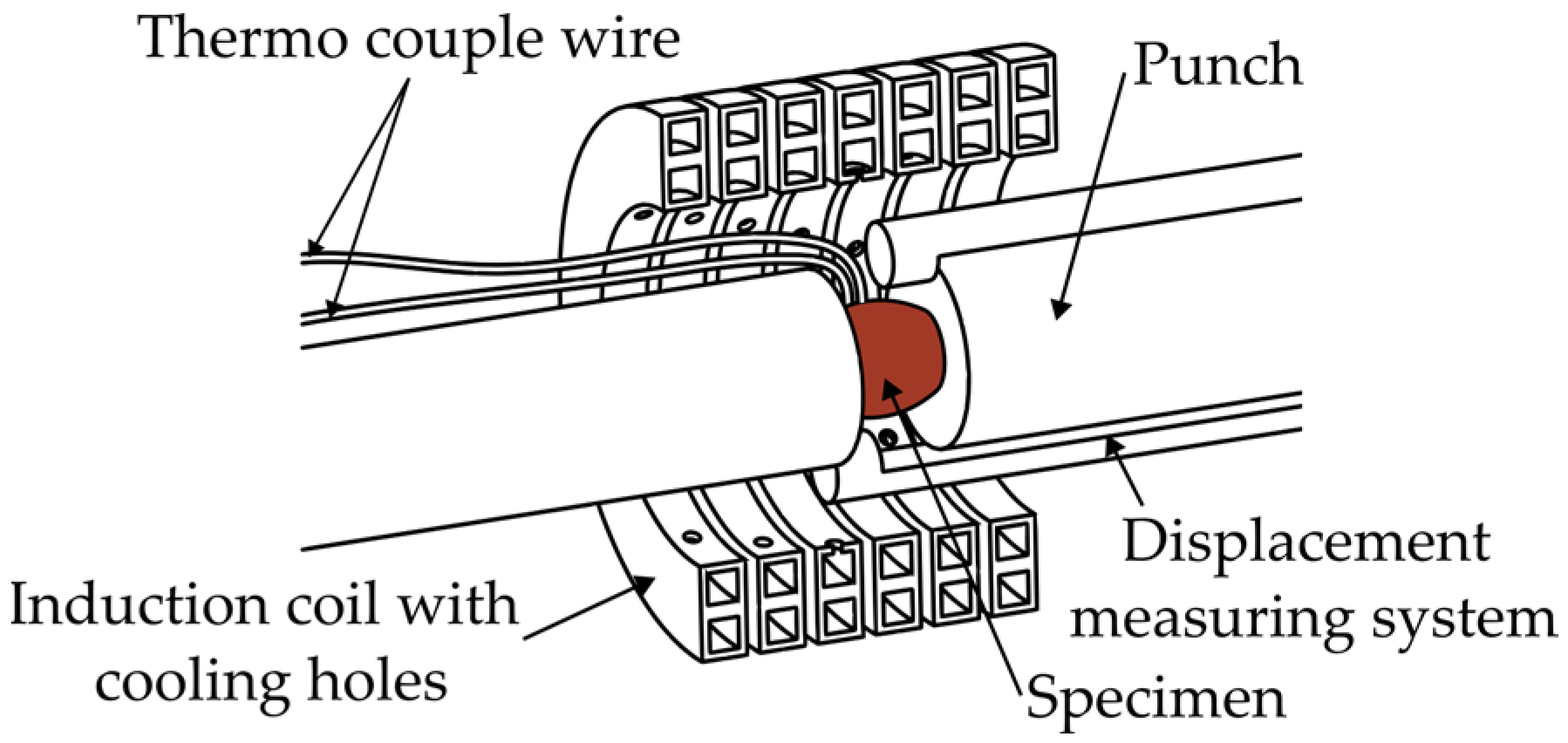
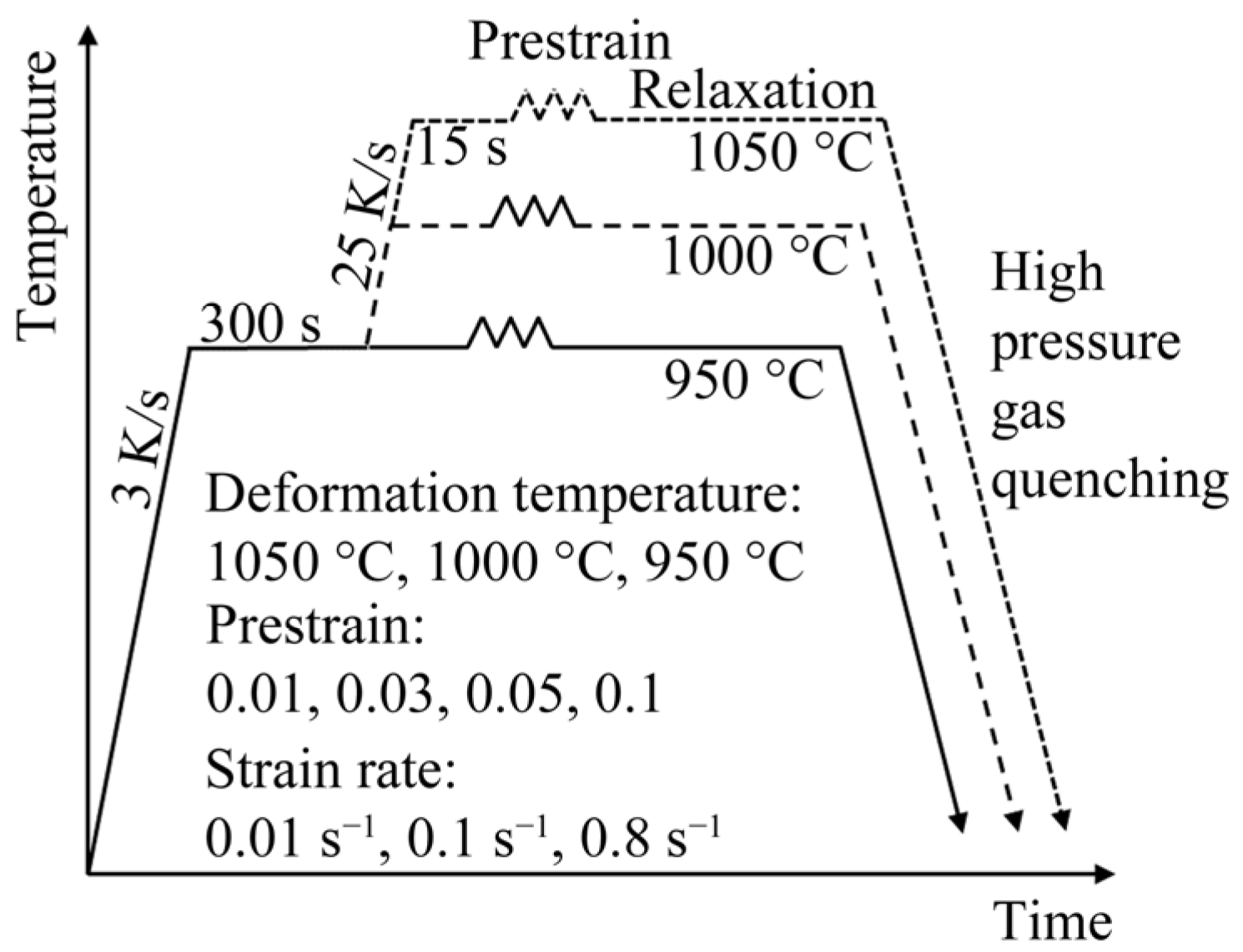
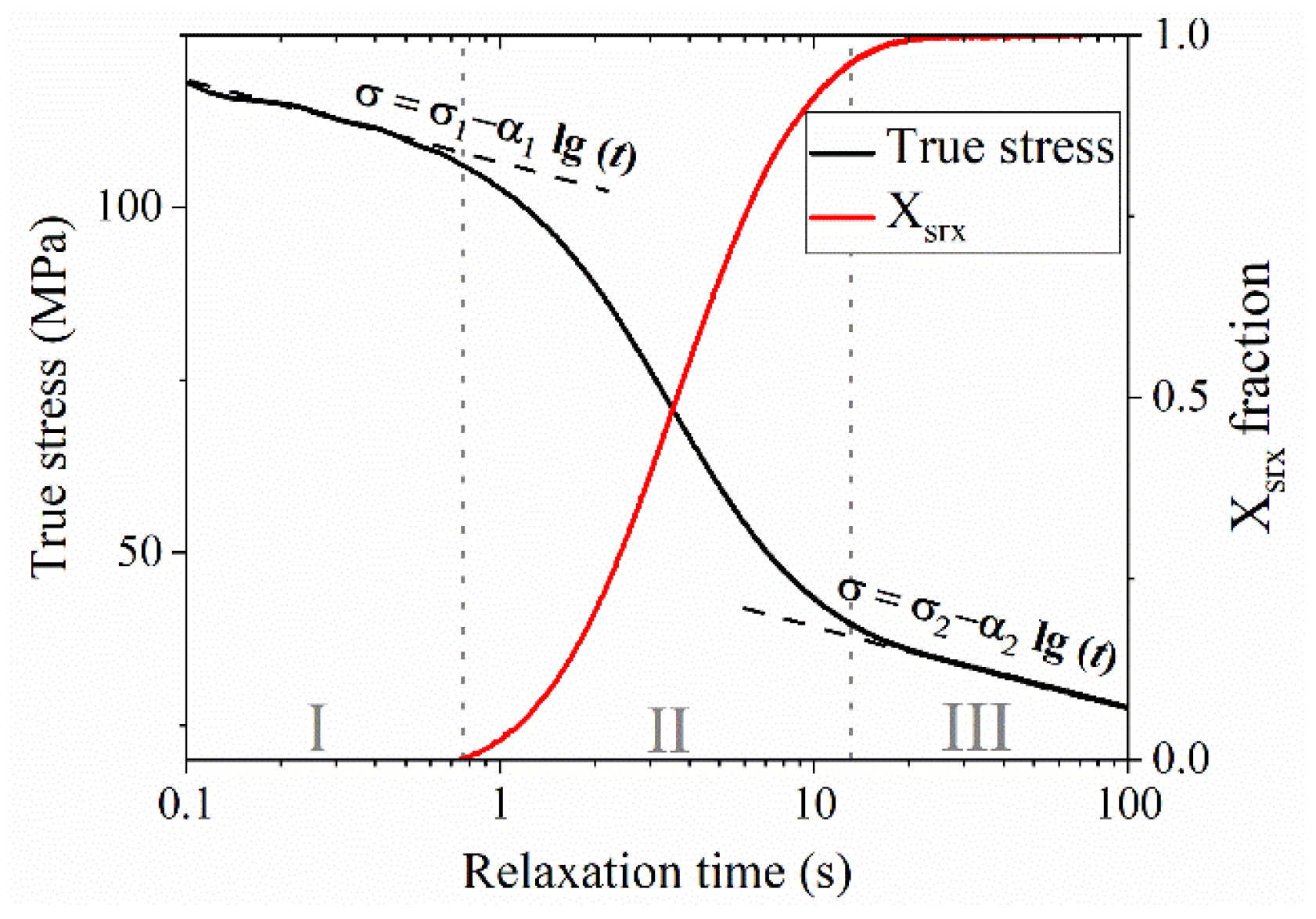
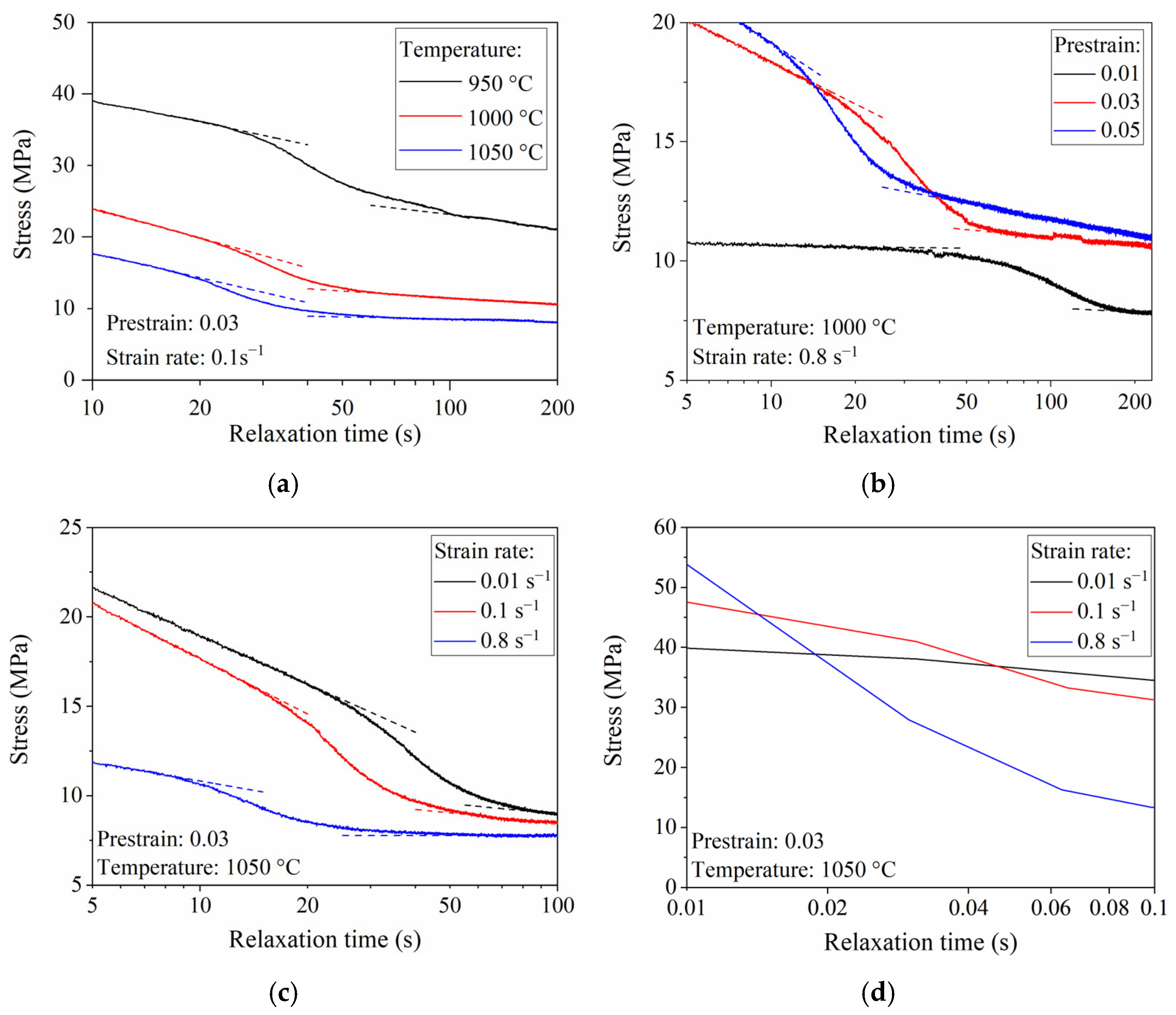




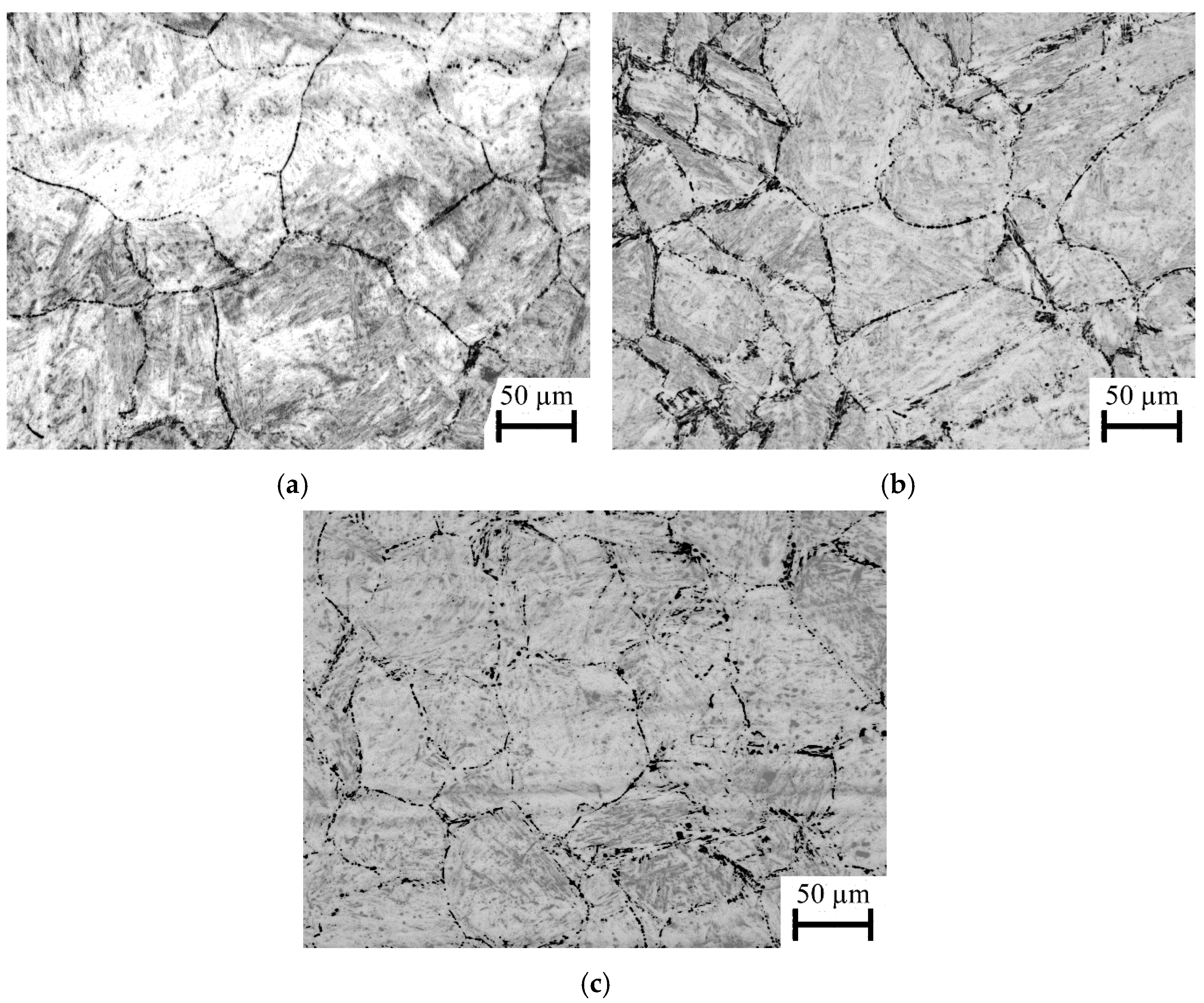
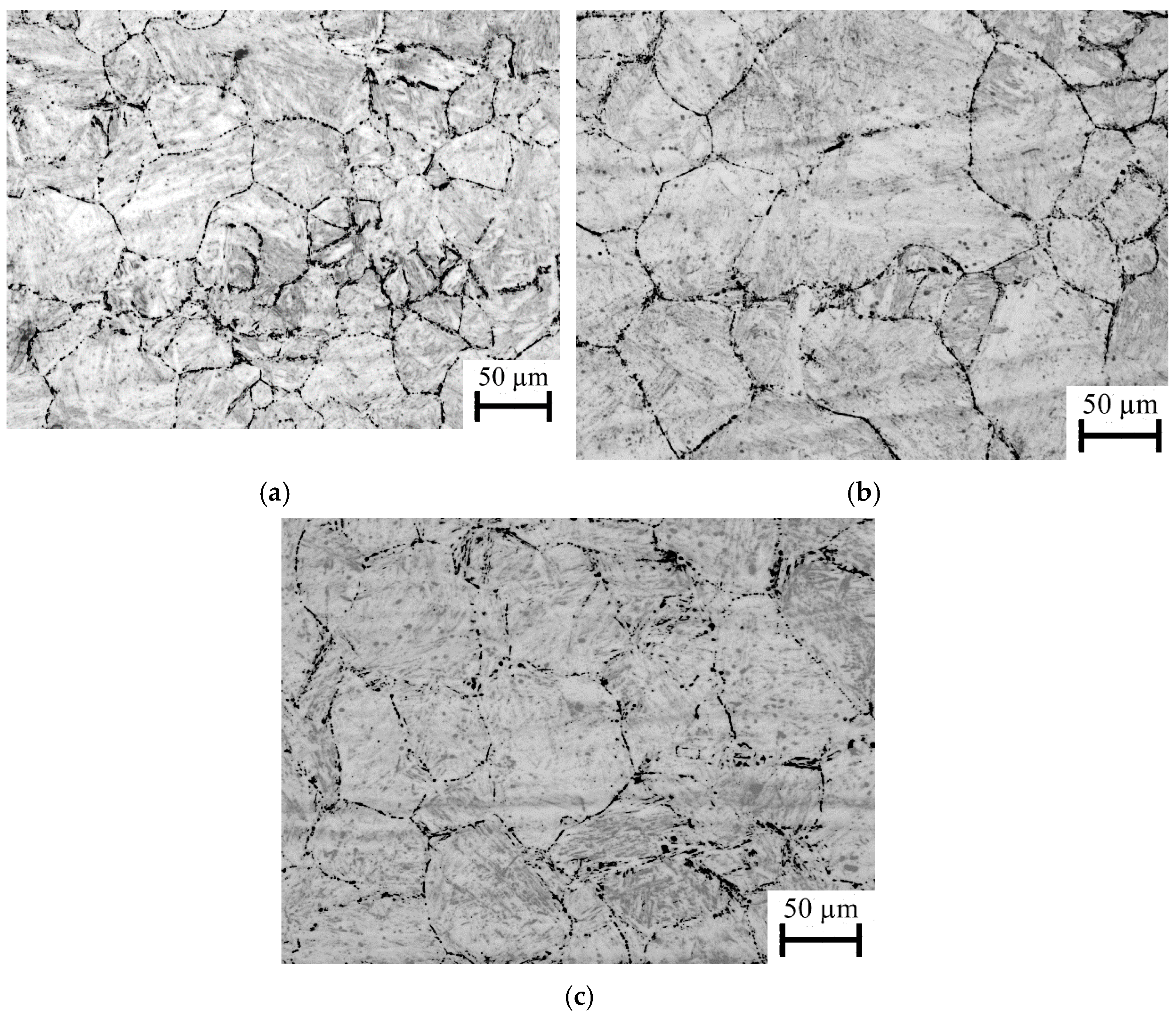
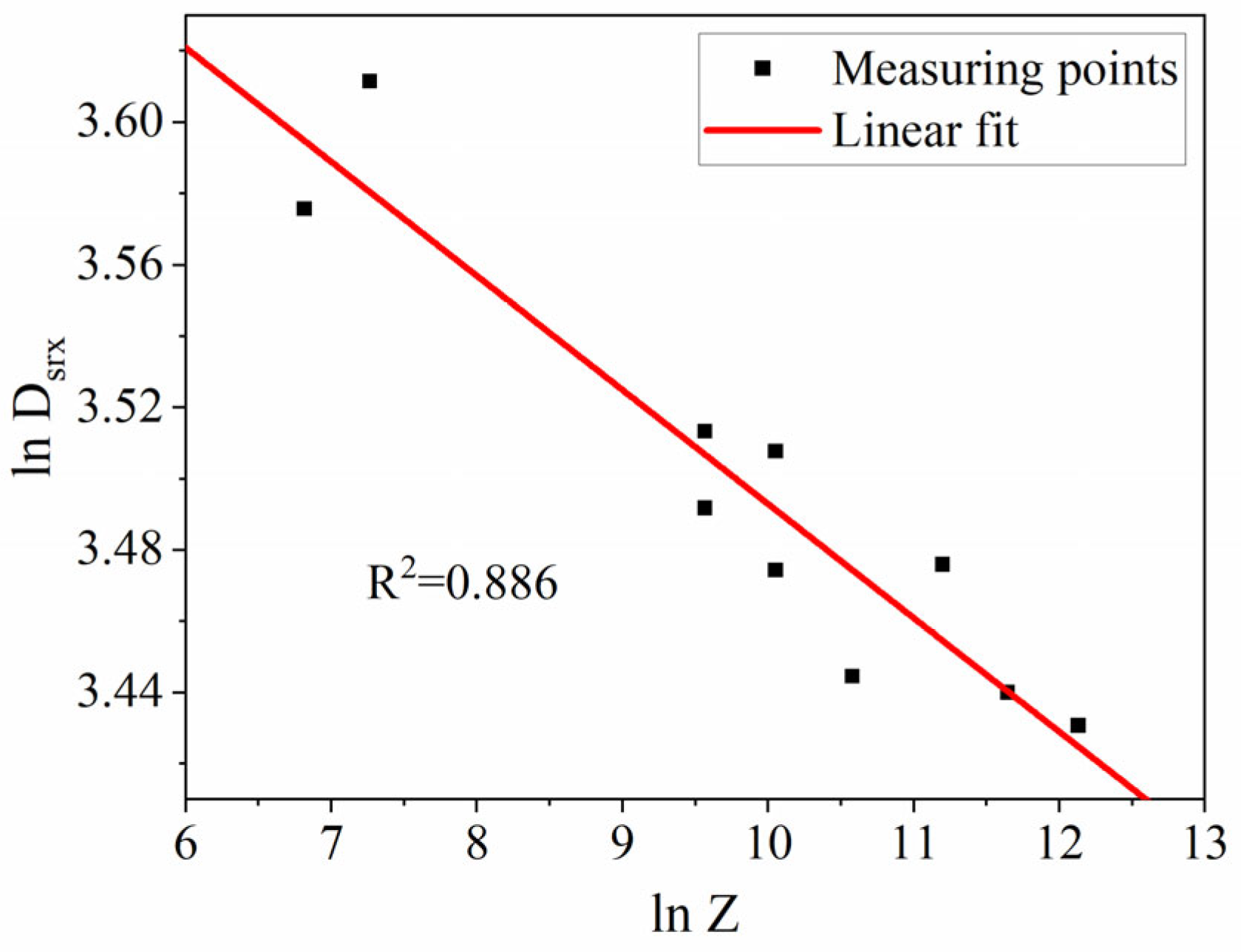
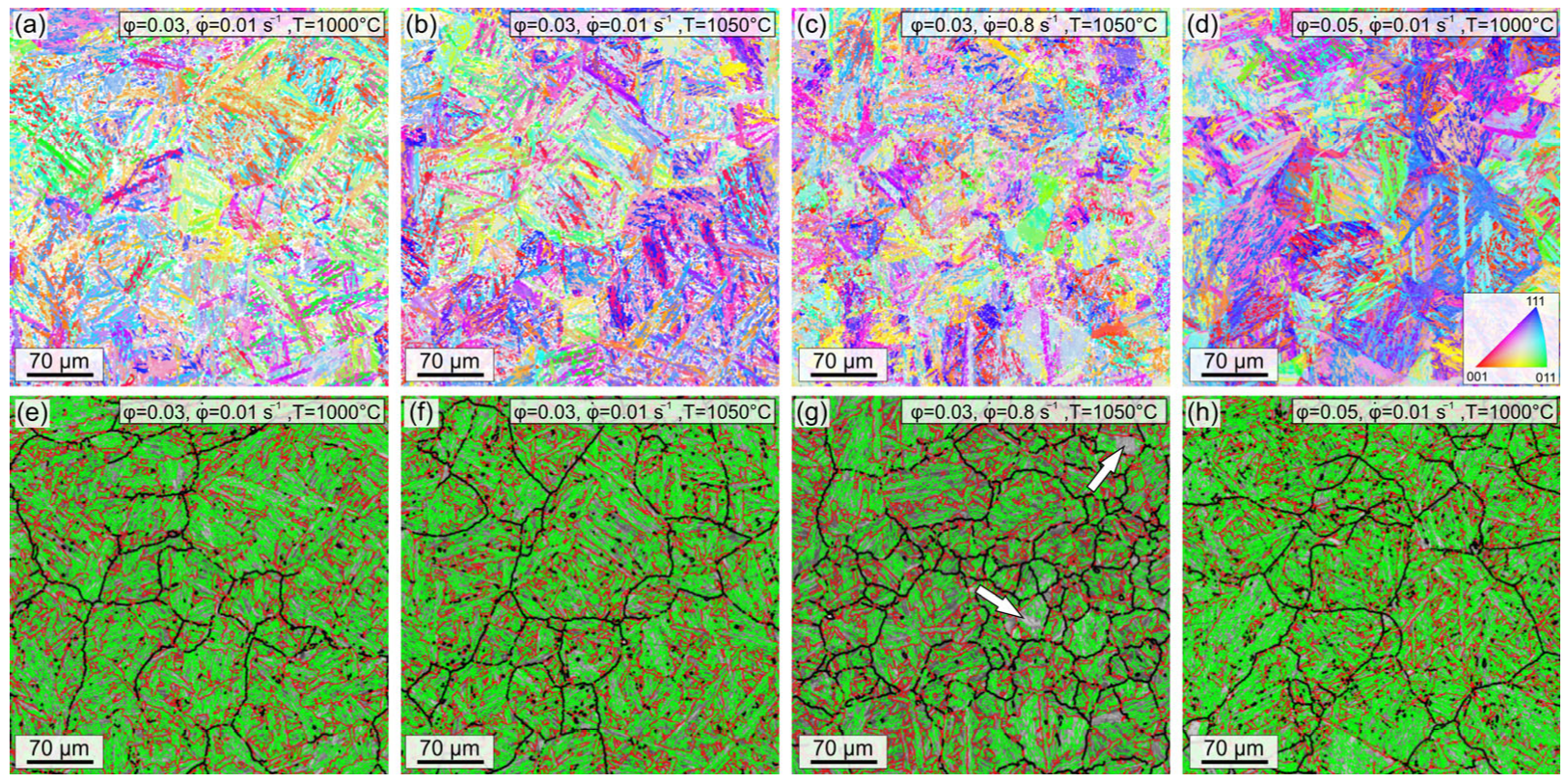
| C | Si | Mn | P | S | Al | Ti | Nb |
|---|---|---|---|---|---|---|---|
| 0.2028 | 0.3712 | 1.162 | 0.0135 | 0.00196 | 0.05718 | 0.0325 | 0.00308 |
| B | Cr | Cu | Mo | Ni | Ta | W | V |
| 0.00146 | 0.2688 | 0.0301 | 0.03936 | 0.05882 | 0.00736 | 0.005 | 0.0045 |
Disclaimer/Publisher’s Note: The statements, opinions and data contained in all publications are solely those of the individual author(s) and contributor(s) and not of MDPI and/or the editor(s). MDPI and/or the editor(s) disclaim responsibility for any injury to people or property resulting from any ideas, methods, instructions or products referred to in the content. |
© 2023 by the authors. Licensee MDPI, Basel, Switzerland. This article is an open access article distributed under the terms and conditions of the Creative Commons Attribution (CC BY) license (https://creativecommons.org/licenses/by/4.0/).
Share and Cite
Birnbaum, P.; Pilz, S.; Neufeld, K.; Kunke, A. Investigating the Static Recrystallization Behavior of 22MnB5 Manganese–Boron Steel through Stress Relaxation Analysis. Metals 2023, 13, 1646. https://doi.org/10.3390/met13101646
Birnbaum P, Pilz S, Neufeld K, Kunke A. Investigating the Static Recrystallization Behavior of 22MnB5 Manganese–Boron Steel through Stress Relaxation Analysis. Metals. 2023; 13(10):1646. https://doi.org/10.3390/met13101646
Chicago/Turabian StyleBirnbaum, Peter, Stefan Pilz, Kai Neufeld, and Andreas Kunke. 2023. "Investigating the Static Recrystallization Behavior of 22MnB5 Manganese–Boron Steel through Stress Relaxation Analysis" Metals 13, no. 10: 1646. https://doi.org/10.3390/met13101646





